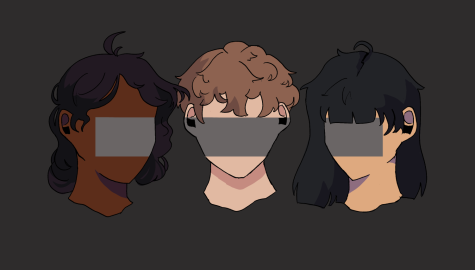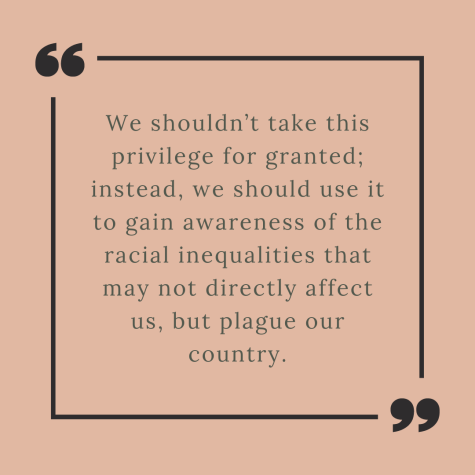Race: An indispensable myth
Examining the significance of the social construct in modern society
February 24, 2022

In a society that is heavily influenced by materialistic ideals, the intangibility of race seeps through the jagged cracks of our nation’s foundation and lingers in the air we breathe.
Although MVHS often doesn’t feel its effects due to the racial homogeneity within the community, race is present in every corner of society –– even if it is entirely a social construct. It’s our responsibility to understand its impacts, especially as we honor the struggles and contributions of African Americans during Black History Month.
As of recent years, the concept of race as a genetic trait has been dismantled through multiple studies providing there are no marked genetic variations between different races. Race was propagated first to explain differences in skin color as early as the Renaissance, and then as pseudoscience, justifying white superiority under the guise of “research.”
Although it is a social construct, its presence is inextricably integrated into our lives and impacts us on an individual scale, subconsciously acting as an underlying factor to many of our own decisions. This phenomenon is also known as implicit bias –– the concept that racism is inherently and subconsciously present in much of our behavior, to the point where it is impossible to erase.
Implicit bias is also one of the many factors that lead to the usage of discriminatory comments or actions known as microaggressions. Some include the assumption that “all Asians are good at math” or the misuse of AAVE. Microaggressions are difficult to navigate and often stem purely from ignorance or implicit bias, but innocuous intentions do not justify the impact they can have on both the receiving individual and minorities as a whole.
The MVHS population is disproportionately Asian, leading to a degree of shelteredness within the community. Most of our exposure to other races is through indirect measures — TV shows, news articles and word of mouth are just a few ways that common stereotypes and prejudices are imposed on us at an early age. The fostering of these preconceived notions leads to implicit bias and as our society moves away from explicit racism –– claiming to enter a more inclusive phase –– implicit bias is slowly taking over and it’s our responsibility to acknowledge and address it.
Implicit bias is a difficult dilemma to approach, as many people are either unaware of their own or unwilling to confront it. The first step to combating it is to understand that implicit bias is an inevitable result of our environments. We cannot control the content that influences our perceptions at a young age, but we do have control of how we process that information now. Those who avoid examining their own biases out of the worry that they will discover their “innate racism” are falling into the apples and oranges fallacy; rather, recognition of our implicit biases shows we’re willing to change and become more racially aware. There are a multitude of ways we can deconstruct our prejudices, from external research to internally examining our logic and reasoning. If you’re interested, consider taking this Harvard test to learn more about implicit bias.
However, completely eliminating implicit bias is an unrealistic goal since its presence is shaped by years of experiences and thoughts. Instead, we should focus on understanding how implicit bias currently influences our behaviors and thoughts and then work on reducing its impacts.
Some individuals are starting to ignore their implicit bias and instead try to explicitly attempt to erase the idea of race by claiming to be blind to color, an idea popularized by the assimilationist perception that is meant to radiate a sense of equality across all races. But ultimately, this mindset only exacerbates racial tensions, masking societal inequities by downplaying their presence.

For MVHS students, racial ignorance can take a different form. We have the privilege to ignore the racial discrepancies outside our community which can lead us to unintentionally view the world through a color blind lens. However, we shouldn’t take this privilege for granted; instead, we should use it to gain awareness of the racial inequalities that may not directly affect us, but plague our country.
In our race-based nation, cultural divisions run deep, influencing how our society functions and impacting individuals on different sides of divides. Minority groups are still confined by the institutional racism that advocates for voting restrictions and the redlining and segregation of cities like Detroit that can expose Black families to poor housing conditions, pollution and more. The negative reaction to attempts to address these discrepancies enforces the influence of race — the critical race theory movement is often criticized for its divisiveness and is banned in many states.
Despite being our first Black American president and understanding the prevalence of racism, former President Barack Obama avoided mentioning race, and instead focused on hard work and determination as a means to social mobility during his presidency. His neglect to acknowledge race fit into the assimilation mindset that praises America’s “meritocracy” and downplayed the struggles minority groups faced, marginalizing them even more. He even criticized Black Americans for “poor moral habits and making excuses for their failure.”
However, when the murderer of 17 year old Trayvon Martin was acquitted in 2012, Obama’s mediating persona faded, and he began directly addressing racial inequities through anectotal speeches and an acknowledgement of advocacy groups such as “Black Lives Matter,” publicizing the racial divide tearing at America. Despite it coming late, Obama’s change in stance goes to show the omnipresence of race and how one can’t ignore it without essentially validating racialized attacks.
Understanding the history of race and its profound influence on modern society is crucial in understanding how society still perpetuates racial inequalities to this day. This is even more relevant this month, where we honor the history of African Americans and acknowledge their persisting struggle for liberation.
We as a community have to not only address societal but also our individual biases. Awareness and acknowledgement, rather than trying to force nonexistent equality through colorblindness or rejection of race, is the first step in the long road to the hopeful destination of eliminating discrimination.
—
RESOURCES:
Implicit bias: What you can (and can’t) do about it
Harvard Implicit Association: https://implicit.harvard.edu/implicit/
How Does Implicit Bias Influence Behavior? – Verywell Mindhttps://www.verywellmind.com › … › Racism
Talking About Race: Thinking Transformatively: https://www.ywcabham.org/talking-about-race-thinking-transformatively
Recognizing and Avoiding Microaggressions: Recognizing and Avoiding Microaggressions – Housing …https://www.housing.utah.edu › avoid_microaggressions
How bystanders can shut down microaggressions: How bystanders can shut down microaggressions – American …https://www.apa.org › monitor › 2021/09 › feature-byst…














